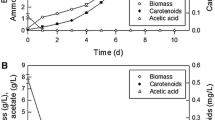Abstract
We sought the optimum conditions for the production of benzonitrilase by Rhodococcus rhodochrous J1. The use of isovaleronitrile or isobutyronitrile as an inducer greatly enhanced benzonitrilase formation. When Rhodococcus rhodochrous J1 was cultivated at 28°C for 96 h in a medium consisting of 0.1 ml of isovaleronitrile, 0.5 g of polypeptone, 0.3 g of malt extract, 0.3 g of yeast extract and 1 g of glycerol per 100 ml of tap water (pH 7.2), and isovaleronitrile was fed twice at the concentrations of 0.1% (v/v) and 0.2% (v/v) at 55 h and 77 h, respectively, during the course of cultivation, the enzyme activity in the culture broth reached approximately 3,100-times higher than the initially obtained level.
Similar content being viewed by others
References
Asano Y, Tani Y, Yamada H (1980) A new enzyme, “nitrile hydratase”, which degrades acetonitrile in combination with amidase. Agric Biol Chem 44:2251–2252
Asano Y, Yasuda T, Tani Y, Yamada H (1982) A new enzymatic method of acrylamide production. Agric Biol Chem 46:1183–1189
Bandyopadhyay AK, Nagasawa T, Asano Y, Fujishiro K, Tani Y, Yamada H (1986) Purification and characterization of benzonitrilases from Arthrobacter sp. strain J-1. Appl Environ Microbiol 51:302–306
Bradford MM (1976) A rapid and sensitive method for the quantitation of microgram quantities of protein, utilizing the principle of protein dye binding. Anal Biochem 72:248–254
Kent RE, McElvain SM (1955) Isobutyramide. In: Horning EC (ed) Organic synthesis Coll, vol 3. Wiley, New York, pp 490–492
Laemmli UK (1970) Cleavage of structural proteins during the assembly of the head of bacteriophage T4. Nature (Lond) 227:680–685
Nagasawa T, Ryuno K, Yamada H (1986) Nitrile hydratase of Brevibacterium R312: purification and characterization. Biochem Biophys Res Commun 139:1305–1312
Nagasawa T, Nanba H, Ryuno K, Takeuchi K, Yamada H (1987a) Nitrile hydratase of Pseudomonas chlororaphis B23: Purification and characterization. Eur J Biochem 162:691–698
Sugiura T, Kuwahara J, Nagasawa T, Yamada H (1987b) Nitrile hydratase. The first non-heme iron enzyme with a typical lowspin Fe(III)-active center. J Am Chem Soc 109:5848–5850
Yamada H, Ryuno K, Nagasawa T, Enomoto K, Watanabe I (1986) Optimum culture conditions for production by Pseudomonas chlororaphis B23 of nitrile hydratase. Agric Biol Chem 50:2859–2865
Author information
Authors and Affiliations
Rights and permissions
About this article
Cite this article
Nagasawa, T., Kobayashi, M. & Yamada, H. Optimum culture conditions for the production of benzonitrilase by Rhodococcus rhodochrous J1. Arch. Microbiol. 150, 89–94 (1988). https://doi.org/10.1007/BF00409723
Received:
Accepted:
Issue Date:
DOI: https://doi.org/10.1007/BF00409723




